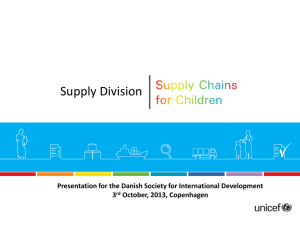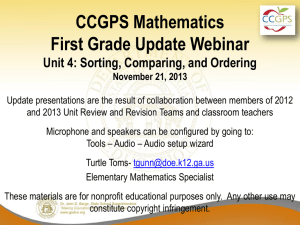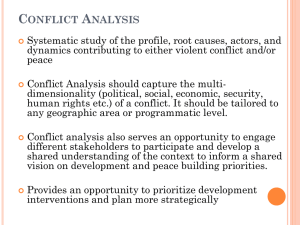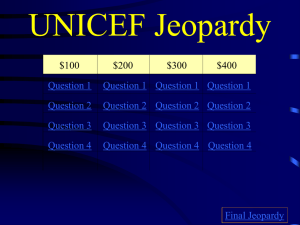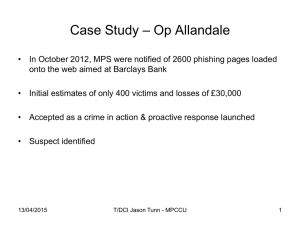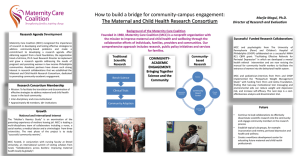ETU LIQUID WASTE MANAGEMENT
advertisement
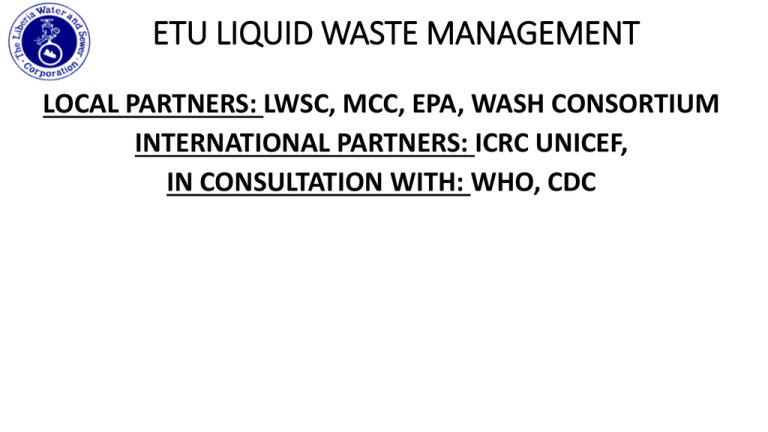
ETU LIQUID WASTE MANAGEMENT LOCAL PARTNERS: LWSC, MCC, EPA, WASH CONSORTIUM INTERNATIONAL PARTNERS: ICRC UNICEF, IN CONSULTATION WITH: WHO, CDC ETU LIQUID WASTE MANAGEMENT THE PROBLEM STATEMENT: The national strategy: • Detect and isolate Ebola cases for treatment and • Prevent further infection. To this end, Government and the partners have constructed a number of Ebola Treatment Units (ETUs) and Community Care Centers (CCCs). The high volumes of infectious waste generated dictate that safety protocols for waste management be put in place. Two broad types of waste are generated from the ETUs – solid and liquid wastes. Protocols are in place for infection prevention in hospitals. UNICEF has developed a document to guide the planning of WASH packages for ETUs. The solid waste is basically segregated and disposed-off in incinerators. The biggest challenge is with the collection and disposal of the sewage, including feces, waste water from showers and laundry. ETU LIQUID WASTE MANAGEMENT PROPOSED SOLUTION Based on research and publications on the Ebola virus and its survival rates outside the body of an infected person, a plan to safely remove and stare liquid wastes from ETUs has been jointly developed by partners in the WASH Consortium taking into account the following: • The sewage from the infected person is highly contagious and must be handled with care. • The virus is inactivated when exposed to temperatures between 58oC – 60oC for 1 hour or 75oC for 30 minutes. • The high chlorinated water used for flushing the toilet and disinfection is able to reduce the viral load in the flushed toilet. ETU LIQUID WASTE MANAGEMENT PROPOSED SOLUTION ETU LIQUID WASTE MANAGEMENT FECAL WASTES AND SEPTIC DESIGNS AT ETUS ETU LIQUID WASTE MANAGEMENT FECAL WASTES AND SEPTIC DESIGNS AT ETUS • Sewage is stored in a septic tank or lined latrine where it can be desludged by a sewer truck. • Sewage is well handled in the ETUs. The Plan aims at safe handling and management from the septic tank or lined latrine to a final disposal site. • The septic tank must be located in an area outside the Red Zone and fenced to avoid unauthorized access, with clear unobstructed access. • The septic tank or the lined pit must have a 4 inch PVC suction pipe with a connector inserted in it and at least 6 inches above the base of the tank, to avoid opening the manhole during the desludging process. ETU LIQUID WASTE MANAGEMENT COLLECTION OF WASTES AT ETU-PRFOTOCOLS BASIC REQUIREMENTS FOR SAFETY Physical structures Changing Room with shower at Fiamah Truck disinfection area (at ETUs and Fiamah) Septic tank with 4 inch pipe inserted and capped 1 drum incinerator located at the Equipment 1 desludging truck 1 escort pickup 2 No. 200 liter Drum for 0.5% chlorine water 1 Drum of clean water 1 Backpack sprayer 2 Hand sprayers 3 Hand sanitizer 1 Basin for footbath Human Resources Chemist Sewer Manager Technician Sewage truck Operator Plumbers Drivers Personal safety gear Consumables Rubber boots 60 liter Reusable hand gloves disposable Water proof plastic waste protective dress bags (many) Rubber apron HTH 70% Safety goggles/eye shield Face mask Nose mask Safety helmet ETU LIQUID WASTE MANAGEMENT TRAINING • Overall Objective: To train cesspit emptier truck crew members to adequately handle and dispose of fecal waste from Ebola Treatment Units (ETUs) • Specific Objectives: provide adequate information on EVD for cesspit emptier truck crews and personnel dealing with liquid waste; train cesspit emptier truck crews and personnel on safe use of PPE; train relevant staff to prepare various chlorine solutions and safely handle chlorine, HTH; and train cesspit emptier crews on safe transportation and disposal of liquid waste. • Number of participants : 25 persons - participants will come from the following agencies: LWSC 16; N. C. Sanitors -4; Libra Inc. -4; EPA – 1 • Date: 27 to 28 November 2014 ETU LIQUID WASTE MANAGEMENT COLLECTION OF WASTES AT ETU-PROTOCOLS Layout principles of the structures and physical facilities Septic tanks and holding tanks at the ETUs/CCCs • All holding pits or septic tank sites should be prepared to allow easy and safe assess for the sewage and utility truck • All the sites should be sealed and clearly labeled as danger zone to prevent unauthorized access • Only the desludging crew and ETU supervisors are allowed access during the dislodging process • All the tanks should have a suction pipe installed into it and capped, allowing easy access to suction without opening the manhole. • The suction pipe should be a 4 inch with a coupler at the end and inserted at least 6 inches from the base of the septic tank • Water should be connected from the ETU/CCC to the sewage area and a changing room provided • Truck platform should be in concrete or gravel layer of at least 6 inches and connected to a soak pit ETU LIQUID WASTE MANAGEMENT Transporting route • LWSC will map out the approved route • A contingency plan to be developed in the event of an accident during transporting • The truck will be escorted by the utility vehicle Holding tank at Fiamah • The digester area is fenced and secured • An on-site security will be provided • Changing room, shower and toilet facilities are provided • Waste will be held in digester and only discharged when it has been tested ad found Ebola free SOCIAL MOBILISATION • The key partners for this program are : • • • • • • community dwellers of Fiamah, the Liberia Water and Sewer Corporation (LWSC), Environmental Protection Agency (EPA), Monrovia City Corporation (MCC), Community Development Services (CODES) United Nations Children’s Fund (UNICEF). TARGET GROUPS • Community leaders (5 committees with 7 committee members) • Youth of the surrounding communities (20 representatives) • Religious groups (6 churches/ 2 mosques) • Community Resident (Estimated population??)- Immediate surrounding (only 1 community) • ETU Managers and staffs • IMS Task force • General audience / Greater Monrovia SOCIAL MOBILISATION TARGET GROUPS WHO WHAT WHEN Sources of verification Community leaders (5 committees with 7 committee members) MCC Initial meeting Pre meeting Weekly meeting 25/10/2014 1/12/2014 Until mid January Minutes of Meeting Pictures Youth of the surrounding communities (20 representatives) MCC CODES Initial meeting Visit of plant Weekly meeting 3 meetings in total Minutes of Meeting Pictures Religious groups (6 churches/ 2 mosques) CODES Church/mosque announcement Meeting 1/12/2014 Minutes of Meeting Pictures Community Resident (Estimated population??)- Immediate surrounding (only 1 community) CODES LWSC UNICEF MoPW Developing message (LWSC/UNICEF) Door to Door Hygiene promotion programs Mapping the risks (road access) 1/12/2014 Package of messages Door to Door reports FGD reports Hygiene kits distribution plan and PMD ETU Managers and staffs LWSC EPA WASH Cluster Contact list (WASH cluster) Request process (WASH cluster) Meetings with WASH manager (LWSC/UNICEF/WHO/EPA/ICRC) 2/12 Minutes of Meeting Pictures IMS Task force LWSC UNICEF Presentation 24/11 Minutes of meeting (IMS) presentation General audience / Greater Monrovia UNICEF LWSC MCC Developing message (LWSC/UNICEF) Radio Program Press release Mid december MONITORING AND EVALUATION FRAMEWORK OJBECTIVES Ensure that the request process is efficient and allow quick desludged Ensure that safety gears, usage and availability of the PPE, equipment, chorine for the staffs/workers are adequate INDICATORS % of request responding in less than 48h (working days) WHERE WHEN ETU CCC Monthly interviews of ETU managers Based on every Request Safety gear and LWSC Field visit equipment are office available for a period of 1 month in the stock LWSC workers are using properly the safety gears and equipment Ensuring that the SOP and % of collection done ETU CCC Every collection safety measures are according to the SOP Field visit implemented in compliance based on the numbers with the standards during of collection the collection process WHO EPA, UNICEF TOOLS MCC, Interviews checklist LWSC / NWSHP Database of the Committee request EPA, WHO Checklist to put on and take off PPE Reports on the field visits EPA, LWSC, MoPW, MCC WHO,and UNICEF ETU WASH managers SOP for collection Reports on the field visits MONITORING AND EVALUATION FRAMEWORK OJBECTIVES Ensuring that the SOP and safety measures are implemented in compliance with the standards during the transport process INDICATORS WHERE WHEN % of transport / Transpo Every transport movement of sludge rt Field visit done according to the SOP based on the numbers of transport WHO EPA, LWSC, MoPW, MCC WHO and UNICEF Ensuring that the SOP and safety measures are implemented in compliance with the standards for the final disposal (appropriate discharge procedures), safety gears and equipment properly disinfected and/or incinerated. % of discharge done according to the SOP based on the numbers of discharge EPA, LWSC, MoPW, MCC WHO and UNICEF Final Every transport disposal Field visit FIAMAH treatme nt Plant TOOLS Log Book, interviews of the transporters, spot check, supporting team on a different vehicle to follow the trucks SOP for discharge procedures Spot check MONITORING AND EVALUATION FRAMEWORK OJBECTIVES Ensuring that feedback (satisfaction and opinion) of the community and the staff is documented and actions are taken to redress the issues Ensuring the implementation of the plan of actions INDICATORS % of workers satisfied % of community members received clear information regarding the Fiamah treatment plant % of request from communities responded # of meetings on the workplan # of plan of actions responding to the needs identified WHERE WHEN LWSC On-going / Union periodical feedback Commu sessions and nity community members. MCC On-going WHO TOOLS LWSC, MCC, Interview and UNICEF, CODES FGD with the LWSC workers UNION Interview and FGD with the community TASK Force chaired by MCC Meeting with minutes ETU LIQUID WASTE MANAGEMENT THANK YOU
